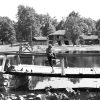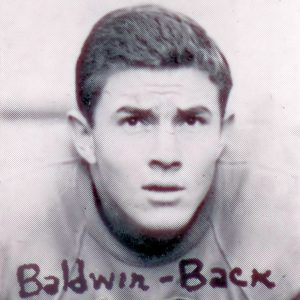calsfoundation@cals.org
Al Baldwin (1923–1994)
Hampered by a chronic bone infection, Al Baldwin underwent five different foot surgeries in high school before becoming an All-American football player at the University of Arkansas in Fayetteville (Washington County) and going on to a brief but productive career in professional football.
Alton (Al) Baldwin was born on February 21, 1923, in Hot Springs (Garland County) to John A. Baldwin, who was a farmer, and Polly Holmes Baldwin, a housekeeper. He had several half siblings.
Baldwin was an all-state end at Hot Springs High School, helping the Trojans win a state championship as a senior in 1942. His extraordinary speed and endurance had been on display from an early age, when he purportedly outran a streetcar on his way home from a job at the local drugstore.
Described by Orville Henry as “the traditional Arkansas end, rangy, lean and fast,” Baldwin actually began his collegiate career at UA as a running back, though he had to play with an iron brace fastened to his cleat; as Glen Rose, his coach, noted about Baldwin: “He had a big bunion on one foot. We had to make an iron brace to protect it. It fastened on to the cleats and became kind of a stirrup.”
Baldwin was the team’s principal offensive threat, leading the Razorbacks in scoring between 1943 and 1945. He became the first Razorback to catch three touchdowns in a game in 1944, replicating the feat a year later. But he was cut from the team in 1945 for being “a center of dissension.” Sources differ about this; the November 8, 1945, Arkansas Gazette reported simply that he was dropped for the “best interests” of the team, while a later book claimed that Baldwin had “a too-casual approach to training regulations.”
With John Barnhill taking over the program in 1946, Baldwin returned to the team and was “straightened out” by the coach and was named first team All-Southwest Conference and second team All-American by the Associated Press.
Playing alongside Clyde Scott, Muscles Campbell, and high school teammate Bud Canada, Baldwin and the 1946 Razorbacks reeled off a surprising campaign to finish as co-champions of the Southwest Conference. UA earned its first trip to the Cotton Bowl, where the Razorbacks played Louisiana State University to a scoreless tie in the wake of an ice storm. Baldwin was selected as one of the game’s two MVPs.
Baldwin had a short but prolific career in professional football before arthritis forced him to retire. He was drafted three times—twice by the National Football League (NFL)—but signed with its competitor, the All-America Football Conference (AAFC), after being picked No. 2 overall by the Buffalo Bills in the 1947 AAFC draft.
As a rookie, he finished among the AAFC’s top ten in receptions, receiving yards, and receiving touchdowns. In 1948 and 1949, Baldwin was named to consecutive all-pro teams after improving to a top-three receiver in the aforementioned categories, trailing only future NFL Hall of Famer Mac Speedie in receptions both seasons.
Baldwin joined the NFL’s Green Bay Packers in 1950, dropping from the ranks of the league’s best receivers, but he remained the Packers’ top pass-catcher. Baldwin spent three years playing in the Canadian Football League. He was a player/coach for the 1951 Ottawa Rough Riders, which won the Grey Cup—Canada’s Super Bowl.
Baldwin returned to Arkansas after retiring from pro football, settling in Hot Springs. He married Joan Luebben of Hot Springs in 1947; they had three children.
Baldwin worked for Arkansas Power and Light Co. (AP&L) as a heating and cooling specialist, retiring in 1972. He was heavily involved in youth sports, refereeing high school football, coaching Boys Club sports, and serving on the Boys Club board.
He was inducted into the Arkansas Sports Hall of Fame in 1987 and the University of Arkansas Sports Hall of Honor (posthumously) in 2001. He was also named to UA’s all-century team and selected as a member of its 1940s all-decade team. The Arkansas Democrat-Gazette named Baldwin to its All-Time Arkansas High School Football Team.
Baldwin died on May 23, 1994. He is buried in Calvary Cemetery in Hot Springs.
For additional information:
“Al Baldwin.” Pro-Football-Reference.com. https://www.pro-football-reference.com/players/B/BaldAl00.htm (accessed February 12, 2025).
Bailey, Jim. “Offense or Defense, Baldwin Filled Every Bill.” Arkansas Gazette, January 24, 1987, pp. 1C, 7C.
Henry, Orville, and Jim Bailey. The Razorbacks: A Story of Arkansas Football. Huntsville, AL: Strode Publishers, 1973.
Reising, Bob. “Garland County: Alton ‘Al’ Baldwin.” 501 Life, September 16, 2017. https://501lifemag.com/garland-county-alton-al-baldwin/ (accessed February 12, 2025).
Brandon Howard
Fayetteville, Arkansas
 Recreation and Sports
Recreation and Sports World War II through the Faubus Era, 1941 through 1967
World War II through the Faubus Era, 1941 through 1967 Alton Baldwin
Alton Baldwin  Alton Baldwin
Alton Baldwin 



Comments
No comments on this entry yet.